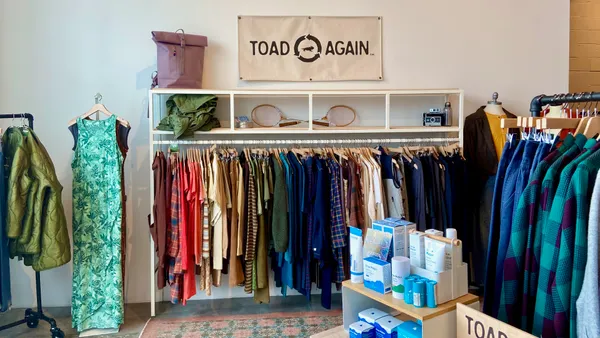Dive Brief:
-
Under Armour on Thursday reported first quarter revenue rose 7% to $1.1 billion, driven by a 4% increase in wholesale revenue to $773 million and a 13% increase in direct-to-consumer revenue to $302 million. Q1 operating income was $8 million, and net loss in the quarter was $2 million or a penny per diluted share. That beat analyst expectations for a 4-cent loss cited by MarketWatch; the beat helped lift shares 9% Thursday morning.
-
The sports gear maker faced headwinds in North America, where Q1 revenue declined 1%, as new distribution was more than offset by the absence of business lost to last year’s bankruptcies. International revenue, including sales in Europe, the Middle East and Africa, the Asia-Pacific region and Latin America, represented 20% of total revenue in the quarter, and rose 52% (or 57% on a currency-neutral basis).
-
Gross margin was down 70 basis points to 45.2%, as benefits from channel and product mix were offset by continued efforts to square inventory with market demand, the company said. Selling, general and administrative expenses rose 12% to $498 million, or 44.6% of revenue (up 210 basis points), due to continued investments in the direct-to-consumer, footwear and international businesses.
Dive Insight:
Under Armour has entered a period of muted growth. That’s understandable considering how swiftly the brand rose in its early years. With maturity comes a certain plateau, suggested Neil Saunders, managing director of GlobalData Retail, in a note emailed to Retail Dive Wednesday.
The sector is under pressure, with bankruptcies (including last year’s collapse of Sports Authority, once the largest sporting goods retailer in the U.S.) limiting domestic wholesale activity, stiff competition helping drive down retail prices and general softness in wider retail.
But some of Under Armour’s woes do stem from its own particular weaknesses, Saunders said. “[W]e do not believe that the travails of the U.S. sports market are solely responsible for Under Armour's lackluster performance,” he said. “Especially as a number of other sporting brands and retailers have done relatively well over a similar period. … While we believe that the brand remains innovative, we do not believe it put its best foot forward over the first part of this year with a lack of range and product innovation making it difficult to generate consumer interest.”
Rival Nike beat expectations for its third quarter, and, after wresting back the number two spot from Under Armour last year, Adidas seems intent on gunning for number one Nike in the space. The brand reported revenue growth in nearly all market segments for the fourth quarter and full-year 2016, and increased its sales and earnings guidance into 2020.
GlobalData Retail took note of the fact that Under Armour is faring better abroad, but said that its performance will remain under pressure until it improves sales and margins, which have been hit by price pressures, in North America. The lower margins of e-commerce, where sales are growing, aren’t helping with that. Under Armour will also need more marketing to remain top of mind for consumers, and those costs will add up.
“This is not to say that the brand is entirely broken in North America, but it does follow that Under Armour is going to have to do a lot more to stimulate demand over the rest of this year,” Saunders said. “Even so, our outlook on profits remains relatively gloomy.”














